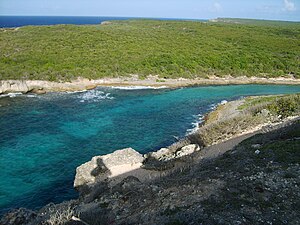Leeward Islands xeric scrub

| Leeward Islands xeric scrub | |
|---|---|
 Grande-Terre Island, Guadeloupe | |
 Ecoregion territory (in blue hashed box) | |
| Ecology | |
| Realm | Neotropic |
| Biome | Deserts and xeric shrublands |
| Geography | |
| Area | 1,554 km2 (600 sq mi) |
| Country | United States, United Kingdom, France, Netherlands, St. Kitts & Nevis, Antigua and Barbuda |
| Coordinates | 16°24′25″N 61°27′36″W / 16.407°N 61.460°W |
The Leeward Islands xeric scrub ecoregion (WWF ID: NT1310) covers the dry ('xeric'), non-forested areas of the Leeward Islands on the northeastern edge of the Caribbean Sea, stretching from the Virgin Islands in the west to Guadeloupe to the southeast. The non-forested areas are generally low scrub shrub, on the low elevations around the peripheries of the islands. Non-forested lower elevations in the region receive less rainfall and are typically semi-arid. A notable feature of the ecoregion is its position in the main hurricane track. The frequent damage to trees allows more pre-climax shrubs and trees to grow. There are a number of endemic species, as in common with islands.[1][2] [3] [4]
Location and description
[edit]The largest island groups with dry shrub areas making up this ecoregion are:
- United States Virgin Islands (US) - eastern portions of the islands
- British Virgin Islands (UK) - eastern portions of the islands
- Saint Kitts and Nevis - low-lying coastal areas
- Antigua and Barbuda - northern Antigua and all of Barbuda
- Montserrat (UK) - low, coastal areas
- Guadeloupe (Fr) - 15% of Basse Terre, the western island, and most of Grande-Terre, Marie-Galante, La Désirade, and smaller islands
There are also smaller islands in the region. The Leeward Islands are formed on two arcs; the inner (western) arc features active volcanos and higher precipitation; the outer arc tend towards limestone-capped submerged volcanos and less precipitation.[1]
Climate
[edit]The ecoregion has a Tropical climate overall, with individual islands having different levels of precipitation that classify them into either Tropical rainforest climate (Köppen climate classification (Af)), Tropical savanna climate - dry winter (Köppen climate classification (Aw)), or Tropical monsoon climate (Köppen climate classification (Am)).[5][6]
Flora and fauna
[edit]The ecoregion features dry seral (intermediate stage of ecological succession) floral communities. These range from herbaceous strand vegetation (plants that grow on the sandy ground above the high-time line of the beach), shrubland (small woody plants), savanna (mixed woodland and grasslands), and littoral woodlands (transitional communities on the edge of full forest).[1]
Plant communities in the region are often associated with the former agricultural use of the land. In areas that were formerly cotton or sugar cane fields, for example, the characteristic species are often gum arabic tree (Acacia nilotica), (Acacia lutea), twisted acacia (Acacia tortuosa), or sweet acacia (Vachellia farnesiana). Areas associated with charcoal production now feature Bursera and Pisonia fragrans. Savanna areas feature acacias, (Prosopis chilensis), and common guava (Psidium guajava).[1]
Protected areas
[edit]Officially protected areas in the ecoregion include:
- Virgin Islands National Park, in the US Virgin Islands
- Guadeloupe National Park, in Guadeloupe
References
[edit]- ^ a b c d "Leeward Islands xeric scrub". World Wildlife Federation. Retrieved December 31, 2020.
- ^ "Map of Ecoregions 2017". Resolve, using WWF data. Retrieved December 31, 2020.
- ^ "Leeward Islands xeric scrub". Digital Observatory for Protected Areas. Retrieved December 31, 2020.
- ^ "Leeward Islands xeric scrub". The Encyclopedia of Earth. Retrieved December 31, 2020.
- ^ Kottek, M.; Grieser, J.; Beck, C.; Rudolf, B.; Rubel, F. (2006). "World Map of Koppen-Geiger Climate Classification Updated" (PDF). Gebrüder Borntraeger 2006. Retrieved September 14, 2019.
- ^ "Dataset - Koppen climate classifications". World Bank. Retrieved September 14, 2019.